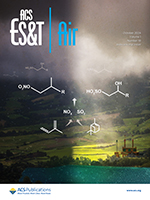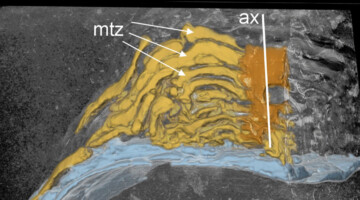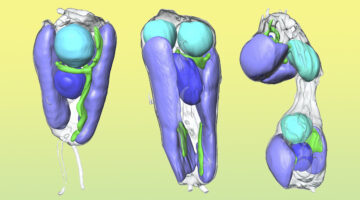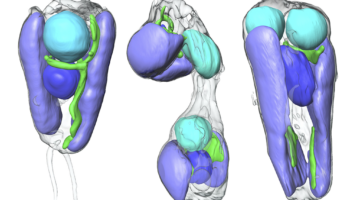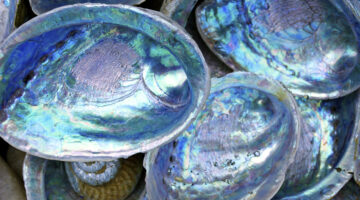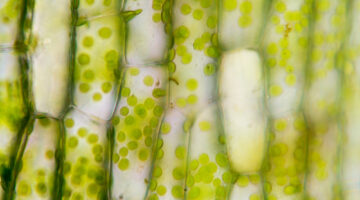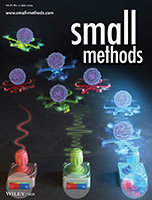This study illustrates the molecular composition of organic aerosols collected in the Houston, Texas, region using direct sampling interfaced with high-resolution mass spectrometry. This study highlights the episodic prevalence and day/nighttime distribution of organosulfates and organonitrates enriched species. Read more »
ALS Work Using Microscopy/Imaging
These techniques use the light-source beam to obtain pictures with fine spatial resolution of the samples under study and are used in diverse research areas such as cell biology, lithography, infrared microscopy, radiology, and x-ray tomography.
Direct Observation of Room-Temperature Magnetic Skyrmion Motion Driven by Ultra-Low Current Density in Van Der Waals Ferromagnets
Researchers demonstrate current-driven magnetic skyrmion motion in van der Waals ferromagnets at room temperature. The skyrmion motion presents ultra-low critical current density to activate their dynamics, thanks to minimized defects in the van der Waals gap. The findings will provide a new platform for spintronics application in the future. Read more »
Surprise Mineral Precursor Found in Coral Skeletons and Mollusk Shells
Researchers studied samples from corals, mollusks, and sea urchins, at edges where mineral precursors start to form the new shell or skeleton. There, they found a surprise: corals and mollusks produced a mineral precursor that had never been observed before in living organisms or rocks, and had only recently been created synthetically. Read more »
Pacific Kelp Forests Are Far Older than We Thought
Researchers scanned newly discovered kelp fossils using x-ray tomography at the ALS. The images provided morphological information about the ancient kelp and, along with isotopic analyses, provided insights into the evolutionary history of northeastern Pacific Ocean kelp forests, which flourished more than 32 million years ago. Read more »
Symbiotic Nitrogen-Fixing Microbe Evolves into Organelle
Researchers found that a symbiont capable of fixing nitrogen (turning it into a biologically usable form) has evolved into an organelle—an intrinsic part of the algae cells that host it. The discovery is of great interest for understanding organelle genesis and for efforts to engineer agricultural plants with built-in nitrogen-fixing capabilities. Read more »![]()
![]()
Scientists Discover First Nitrogen-Fixing Organelle
In two recent papers, an international team of scientists describe the first known nitrogen-fixing organelle within a eukaryotic cell. The organelle is the fourth example in history of primary endosymbiosis—the process by which a prokaryotic cell is engulfed by a eukaryotic cell and evolves beyond symbiosis into an organelle. Read more »
Nitrogen-fixing organelle in a marine alga
A nitrogen-fixing organelle, or “nitroplast,” has been identified in a marine alga on the basis of intracellular imaging and proteomic evidence. This discovery sheds light on the evolutionary transition from endosymbiont to organelle. The image depicts the cell architecture and synchronized cell division of the alga Braarudosphaera bigelowii with nitroplast UCYN-A (large brown spheres). Read more »
Shedding Light on Sea Creatures’ Secrets
Exactly how does coral make its skeleton, a sea urchin grow a spine, or an abalone form the mother-of-pearl in its shell? A new study at the ALS revealed that this process of biomineralization, which sea creatures use to lock carbon away in their bodies, is more complex and diverse than previously thought. Read more »
Watching the Enzymes that Convert Plant Fiber into Simple Sugars
Research from Lawrence Berkeley National Laboratory, Lawrence Livermore National Laboratory, and UC Davis sheds new light on how to access the sugars locked up in plants to produce petroleum-free fuels, chemicals, and medicines. The technique used combines a novel microfluidic device and infrared spectroscopy to study how a cellulose-degrading enzyme works in real time. Read more »
Magnetically Selective Versatile Transport of Microrobotic Carriers
Field-driven transport systems offer the possibility of biofunctionalized carriers for microrobotics, biomedicine, and cell delivery. Here, researchers show how magnetic fields may selectively manipulate and drive microrobotics along a patterned micromagnet. Different-sized magnetic carriers move in multiple directions, including selective rotation and bidirectional movement. Such steering systems can direct the delivery of drugs or cells into artificial microvascular channels. Read more »
- « Previous Page
- 1
- 2
- 3
- 4
- …
- 19
- Next Page »
